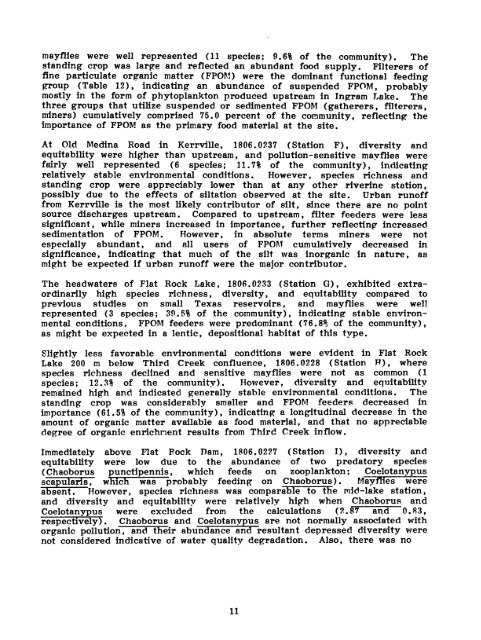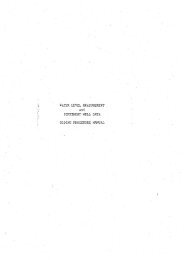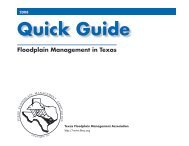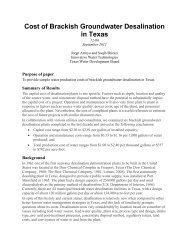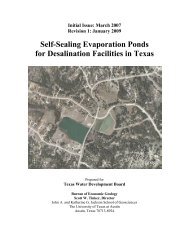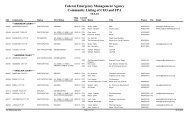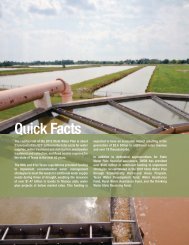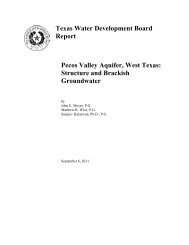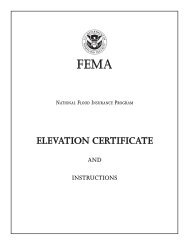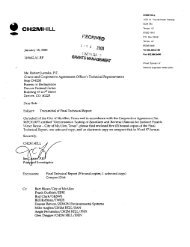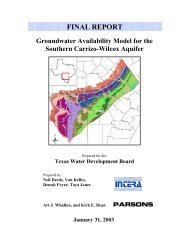Intensive Survey of the Guadalupe River Segment 1806
Intensive Survey of the Guadalupe River Segment 1806
Intensive Survey of the Guadalupe River Segment 1806
Create successful ePaper yourself
Turn your PDF publications into a flip-book with our unique Google optimized e-Paper software.
mayflies were well represented (11 species; 9.6% <strong>of</strong> <strong>the</strong> community). The<br />
standing crop was large and reflected an abundant food supply. Filterers <strong>of</strong><br />
fine particulate organic matter (FPOM) were <strong>the</strong> dominant functional feeding<br />
group (Table 12), indicating an abundance <strong>of</strong> suspended FPOM, probably<br />
mostly in <strong>the</strong> form <strong>of</strong> phytoplankton produced upstream in Ingram Lake. The<br />
three groups that utilize suspended or sedimented FPOM (ga<strong>the</strong>rers, filterers,<br />
miners) cumulatively comprised 75.0 percent <strong>of</strong> <strong>the</strong> community, reflecting <strong>the</strong><br />
importance <strong>of</strong> FPOM as <strong>the</strong> primary food material at <strong>the</strong> site.<br />
At Old Medina Road in Kerrville, <strong>1806</strong>.0237 (Station F), diversity and<br />
equitability were higher than upstream, and pollution-sensitive mayflies were<br />
fairly well represented (6 species; 11.7% <strong>of</strong> <strong>the</strong> community), indicating<br />
relatively stable environmental conditions. However, species richness and<br />
standing crop were appreciably lower than at any o<strong>the</strong>r riverine station,<br />
possibly due to <strong>the</strong> effects <strong>of</strong> siltation observed at <strong>the</strong> site. Urban run<strong>of</strong>f<br />
from Kerrville is <strong>the</strong> most likely contributor <strong>of</strong> silt, since <strong>the</strong>re are no point<br />
source discharges upstream. Compared to upstream, filter feeders were less<br />
significant, while miners increased in importance, fur<strong>the</strong>r reflecting increased<br />
sedimentation <strong>of</strong> FPOM. However, in absolute terms miners were not<br />
especially abundant, and all users <strong>of</strong> FPOM cumulatively decreased in<br />
significance, indicating that much <strong>of</strong> <strong>the</strong> silt was inorganic in nature, as<br />
might be expected if urban run<strong>of</strong>f were <strong>the</strong> major contributor.<br />
The headwaters <strong>of</strong> Flat Rock Lake, <strong>1806</strong>.0233 (Station G), exhibited extra<br />
ordinarily high species richness, diversity, and equitability compared to<br />
previous studies on small Texas reservoirs, and mayflies were well<br />
represented (3 species; 39.5% <strong>of</strong> <strong>the</strong> community), indicating stable environ<br />
mental conditions. FPOM feeders were predominant (76.8% <strong>of</strong> <strong>the</strong> community),<br />
as might be expected in a lentic, depositional habitat <strong>of</strong> this type.<br />
Slightly less favorable environmental conditions were evident in Flat Rock<br />
Lake 200 m below Third Creek confluence, <strong>1806</strong>.0228 (Station H), where<br />
species richness declined and sensitive mayflies were not as common (1<br />
species; 12.3% <strong>of</strong> <strong>the</strong> community). Hov/ever, diversity and equitability<br />
remained high and indicated generally stable environmental conditions. The<br />
standing crop was considerably smaller and FPOM feeders decreased in<br />
importance (61.5% <strong>of</strong> <strong>the</strong> community), indicating a longitudinal decrease in <strong>the</strong><br />
amount <strong>of</strong> organic matter available as food material, and that no appreciable<br />
degree <strong>of</strong> organic enrichment results from Third Creek inflow.<br />
Immediately above Flat Pock Dam, <strong>1806</strong>.0227 (Station I), diversity and<br />
equitability were low due to <strong>the</strong> abundance <strong>of</strong> two predatory species<br />
(Chaoborus punctipennis, which feeds on zooplankton; Coelotanypus<br />
scapularis, which was probably feeding on Chaoborus). Mayflies were<br />
absent. However, species richness was comparable to <strong>the</strong> mid-lake station,<br />
and diversity and equitability were relatively high when Chaoborus and<br />
Coelotanypus were excluded from <strong>the</strong> calculations (2.87 and 0.83,<br />
respectively). Chaoborus and Coelotanypus are not normally associated with<br />
organic pollution, and <strong>the</strong>ir abundance and resultant depressed diversity were<br />
not considered indicative <strong>of</strong> water quality degradation. Also, <strong>the</strong>re was no<br />
11


